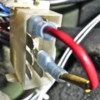I am illeterate in many things, one of them is my Pantera's electricity. I am triing very hard to understand my Hazard switch, I am also looking at Bill Taylor's (SOBill) diagram nut puzzled as far as understanding the function of all of those wires connected to the switch. Would someone have a description of the utilisation for every wire, so far I understand only the light blue and the light blue/black wire fonctions.
I am having problems with the 4 ways and flashers.
Thanks
Original Post


